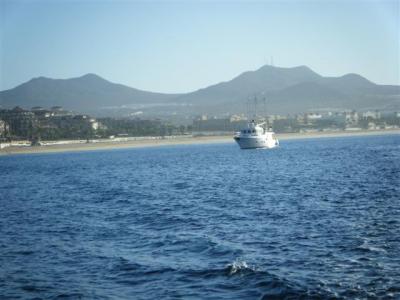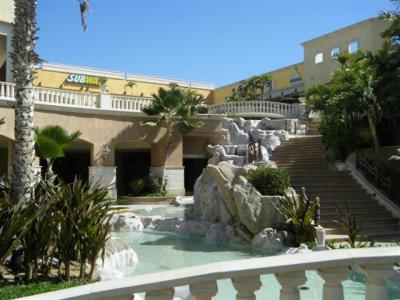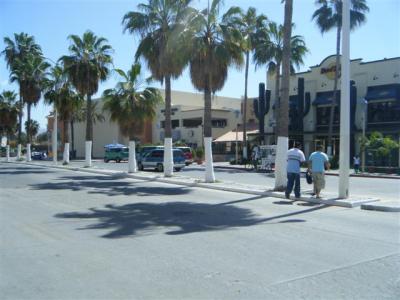This morning the alarm went off at 0630. We both wanted to sleep more, exhausted from the passage. But we had made plans to go to breakfast with a new friend and we needed to get up. The person we were meeting is named Patrick, and he is a blog reader that lives in Los Cabos. He had contacted us a few months ago and offered to show us around town when we were in the Los Cabos area. We have chatted with him quite a bit since then via email, and we were looking forward to meeting him in person.
We got ready and called a water taxi at 0730, figuring he’d get us to shore by 0800. The taxi showed up at 0800 and dropped us off at the water taxi stand, which was a good mile from where we had asked to be dropped off. Here is a shot of Kosmos and Cabo San Lucas from the water taxi.

We called Patrick and told him we were at the wrong place. He told us to stay put and he would find us. We checked out our surroundings while we waited. We were on a boardwalk that wraps around the man made harbor within the natural bay. As far as we could tell, the buildings along the boardwalk appeared to be an endless line of hotels and restaurants. Everything looked to be new and upscale. A cruise ship was in port, and there were lots of tourists walking up and down the boardwalk, along with a lot of touts selling tourist knick knacks and offering assorted tours.
Like Huatulco, Los Cabos is a large, sprawling area. And, similar to Huatulco, 30 years ago there was nothing in Los Cabos except three tiny fishing villages. And like Huatulco, the area has grown explosively in recent years, primarily as a result of tourism. The main tourist center is Cabo San Lucas, where we stood now. It is famous for great sportfishing and really wild bars where you can party hard until dawn.
A few minutes later, Patrick strolled up. It was nice to meet him in person. We walked over to his car and we drove a few blocks back to a popular breakfast haunt. Off the waterfront, it is not as upscale, but it is still nice. The few blocks we saw looks just like an average, middle class area in the US. There are a lot of cars on the road, and both traffic and parking seem to be a big problem. And, it seemed like most of the cars were SUV’s. Are we in LA or Cabo?
The restaurant has the self-proclaimed best French toast in the world. The bread is stuffed with cream cheese and topped with pecans and fruit. It is really darn good, but we still think the place in Nicaragua wins. We also got a lobster benedict and a crab cake benedict, which we’ve never seen before. They were both a typical benedict, with an English muffin, poached eggs and hollandaise sauce, they just swapped lobster/crab for the ham. We like seafood and benedicts, so we liked them a lot.
After breakfast, Patrick volunteered to shuttle us around as we did our errands, which was very kind of him. The first thing on the to-do list was to go to the Port Captain to check in. Patrick didn’t know where the Port Captain’s office is, but he figured it would be on the waterfront close to the marina. We decided to go to the marina to ask for directions. We hopped back in the car and parked at a mall just off the boardwalk, a couple miles away from where Patrick had picked us up. We walked through the mall to get to the boardwalk. The mall is super swanky, with beautiful fountains and high end stores.

When we commented about how “American” Cabo looks, Patrick said that Cabo San Lucas has been nicknamed “Beverly Baja”. The name definitely fits. Anyway, from the mall it was a short walk to the marina office, which is on the boardwalk. Interestingly, there is a boat yard right next to the mall. When we commented about that being odd, Patrick said he thinks the boat yard owner also owns the mall. Ah.
We were surprised when the marina told us that the Port Captain’s office was a few blocks inland. We guess the office in Bahia Navidad isn’t as unusual as we first thought. They gave us a map and we walked over to the office. Here is a street shot to give you a sense of what it looks like.

The Port Captain’s office was crowded and we had to wait a few minutes before being helped. We chatted with the others in line and found out some useful information. First, we could have had the Port Captain in Huatulco clear us for all ports up through Ensenada, which would have eliminated the need to check in and out of each port. Oh well. We gather the officials don’t like to do that since none of the port captains we checked in with ever volunteered that information. And, since our next stop is Ensenada anyway, it is too late to try it out now. Second, the moorings were privately owned and the land was on a 20 year lease from the government. When the lease was up, the government didn’t renew it, so now there are no more moorings. Third, now you are supposed to call API on the VHF to request permission to anchor before actually dropping the anchor. We committed a fairly serious no-no by anchoring without permission. Oops!
Next on the to-do list was to stock up on “bad sea” food food that is easy to eat when it is rocky and miserable and your tummy isn’t happy. That is food like chocolate (tastes the same both directions), fruit, potato chips and crackers. We don’t even really like potato chips and almost never eat them on dry land. But they are great in rough seas!
Patrick drove us to a grocery store in one of the other towns in Los Cabos, called San Jose del Cabo. We took a highway that parallels the water northwest for a surprisingly long distance. We hadn’t quite realized how far apart the two towns are. The stretch of highway is interesting. The side closest to the water is hilly and rife with upscale development, and looks much like Dana Point or any other newer, expensive California beach community. We were shocked when Patrick told us the prices of the hotel rooms, condos and houses on that side of the road. They are the exact same prices you would pay for something comparable in Southern California. Unbelievable!
There are quite a few pockets of land that haven’t been built upon, but most of that land looks like it has been graded for development, so in a few years there may be no vacant land left at all on this side of the road. The other side of the road is almost like a different universe altogether. It looks just like California’s inland desert cities, such as Palmdale. The land is arid and dry, dotted with low growing scrubby and sparse plants. There is a lot of new construction, but there is still tons of vacant land left intact. The construction on this side looks more middle class than on the other side. The prices on this side of the road are significantly lower than the ocean side. One block literally saves you hundreds of thousands of dollars on a house!
The weather in Los Cabos is a bit unusual. It is very close to the Tropic of Cancer line, and the tropical storms don’t usually make it quite that far north (but tropical storms can happen and boats have been damaged in hurricanes that have tracked through here). But, since it is so far south, it also doesn’t normally get the cold Artic storms from the north, either. So, they just don’t get much rain at all.
To be continued”¦
